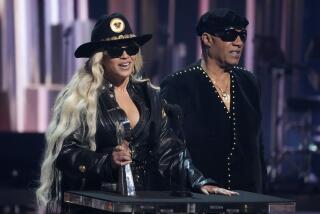Deering Banjo in a groove
It all started with the Kingston Trio.
One day in 1963, a San Diego kid and his friends got their hands on an album by the popular folk group. Greg Deering, 12 at the time, recalls studying the musicians on the cover and thinking, “I’ve got to get a banjo” — not out of love for the twangy instrument but mainly because his pal already had a guitar.
Fifty years later, Greg, his wife, Janet, and daughter Jamie preside over the bestselling banjo-making business in the U.S.
From a small Spring Valley factory, the Deering Banjo Co. is having its best year ever, defying the U.S. skills gap and California’s manufacturing doldrums. It has expanded and trained its own workforce and expects to top $4 million in sales for the year ending June 30.
Greg Deering, 62, is the creative force behind the banjo design and the machinery used to build them. Janet Deering, 58, handles operations. Daughter Jamie Deering, 34, might have the most fun job: liaison with the company’s big-name roster of professional musician customers.
Over the company’s 38-year history, it has developed a loyal following from the likes of Taylor Swift, Keith Urban, the Dixie Chicks, Steve Martin and Mumford & Sons. Artists who play Deering banjos rolled up 13 Grammy nominations this year.
Two of Deering’s fans illustrate how the company has managed to ride the banjo’s renaissance as an instrument that crosses several musical genres as varied as country, reggae and indie rock.
“It’s great working with a family company, an American company that really cares about the artist and making top-quality banjos,” said Jeff DaRosa, singer, bassist and banjo player for the Dropkick Murphys, the Boston-based Celtic punk band.
Scotty Morris, lead vocalist of the contemporary swing revival band Big Bad Voodoo Daddy, called Deering Banjo “the quintessential American instrument builder.”
“When I call Deering, I talk to a Deering, and I like that almost as much as I love the instruments they build,” Morris said.
That kind of reputation combined with specially crafted manufacturing tools and a skilled, veteran workforce has helped the company weather the recession and cheap competition from China. Deering has been able to expand its workforce in a way that other companies have not, growing to 42 workers from 30 a year ago.
Although the nation as a whole has been adding manufacturing jobs, all California has done is reduce the rate of decline, said John Husing, principal of Redlands-based Economics and Politics Inc.
The most recent statistics available show that California ended 2012 with 1.23 million manufacturing jobs, down sharply from nearly 1.9 million in 2000 and marginally below the nearly 1.24 million in December 2011.
If you ask the Deerings what their greatest challenge has been, the answer has been running the business in California, particularly during a run-up in workers’ compensation insurance premiums that began under Gov. Gray Davis.
“That nearly put us out of business. We’re still paying off some of those debts,” Greg Deering said, adding that the company has remained in California mostly because the family considers it home.
“And because we are stubborn. We are so stubborn,” Janet Deering said.
Greg Deering credits his father, who worked in the Southern California aerospace industry, for developing his eye for design.
“He started me out on model airplanes when I was 2,” Deering said. “He turned me loose on my own, making models when I was 5. At age 7, he bought me my first set of drafting tools.”
But it wasn’t until he was a student at San Diego State that he realized just what his father had done for him. There was an assignment to cut a board of certain dimensions from a rough block of wood. He was done with the assignment quickly and began working on a banjo. Weeks later, he realized the other students were still working on the block of wood.
“That was when it clicked for me,” he said, later adding, “my father was a very intense mentor for me. He was teaching me how to be a craftsman.”
Deering’s first manufacturing gig was a brief stint at a Lemon Grove, Calif., business called the American Dream, where he built and repaired banjos and guitars with another entrepreneurial legend of Southern California, Bob Taylor, co-founder and president of Taylor Guitars. (On occasion, the two have teamed up in a music group they call the Lemon Grove Band, but Taylor plays the banjo and Deering plays the guitar.)
In 1975, after a short-lived partnership with another banjo maker, Deering Banjo was born. For a while, the company made dulcimers until the banjo business began to gather steam.
In fiscal 1983, the company had sales of a little more than $182,000. By fiscal 1997, Deering hit $1 million in sales for the first time. Until the current fiscal year, 2006 had been the best, with $3.9 million in sales.
The twin blows of the recession and Chinese competition hit sales hard, dropping them back to about $2.4 million in 2009. By 2011, the company was back over $3 million in sales as the company tightened its processes and consumers felt more flush.
Prices range from $499 to $30,000 for an elaborate model called the Gabriella.
Deering Banjo’s main path to success has been “being efficient. Not being afraid to be innovative,” Greg Deering said.
Inside the 18,000-square-foot factory, he is like a man walking through his garage workshop. He not only designs the guitars and many of the machines that make them, he is still personally involved with the fretting work and inlay work on some of the instruments.
“We just bring pallets of wood in and raw boards and we turn those into banjos,” he said, as if the whole process was simple. It isn’t.
First stop: the wood-cutting room. “This is the room where we cut up the various sizes, and from here they flow out to the workshop,” Janet Deering said.
Next, the wood is machined, twice, as the banjo takes its form.
Machines programmed by Greg Deering do some of the first basic cuts.
“Working with these machines is more fun than going to Disneyland,” he said.
After one machine has carved the neck, a long bolt called a truss rod is inserted to help keep the neck straight.
No hammering or nails or staples here. Gluing comes next.
“Once the truss rod is glued on, the fingerboard is glued on next,” he said. “It’s just simple wood glue.”
The wood has to be treated with care to make the round drums. One set of machines has been specifically designed to heat and bend the wood while keeping it wet with steam.
“Wood becomes very pliable at 320 degrees,” Greg Deering said. “These drums are heated to about 380 to 400 degrees, but we have to steam them to get them wet enough so that they don’t burn.”
The most intricate work, such as the inlays, is done by hand.
“We still do a fair amount of hand work,” he said.
Next, the banjo is “ready for frets,” the horizontal bars on the neck of the banjo. Another machine designed and built by Greg Deering cuts all of the slots for the frets at once.
“We do this every day. We make a lot of banjos,” he said, “but it’s still kind of like magic.”
Some of the equipment is more than 50 years old, like one made for working on metal parts now used for some of the finishing lathe work.
The efficiencies wrought from such a unique work space are unmatched in the industry, Deering said.
“We keep track of our man hours per banjo,” he said, “and this past week, it was three hours per banjo. That’s extremely good. One of the longest takes 20 hours. The Chinese can’t build banjos faster than we do.”
The manufacturing process isn’t the only thing that sets Deering banjos apart.
Fifteen years ago, the company began working with Jens Kruger, considered one of the top virtuoso players in the world. Since the 1940s, banjos had been made from hard maple wood. It was Kruger’s idea — heretical at the time — that the kind of soft maple used in Europe for violins would be better, and it was.
Kruger also helped design a tone ring that has a patent pending that has also helped enhance the sound of Deering banjos.
Mostly, Greg Deering credits his workforce for the quality of the finished product. Some of Deering Banjo’s employees have been at the company for 30 years or more and came with considerable skills.
But he said skills aren’t necessary for the newest employees, trained through an apprenticeship-style program.
“What really matters is that they are conscientious and responsible people,” he said. “That is really the most important thing. The rest can be taught.”
Along the way, he said, there have been moments he said he never could have imagined. One of them was buying the Vega Banjo company, makers of the banjo he had ogled in a music store as a child, but couldn’t afford.
The best might have been making banjos for the members of a certain singing group he once idolized.
“We’ve made banjos for the Kingston Trio,” he said, “and that’s something I never could have imagined happening.”







